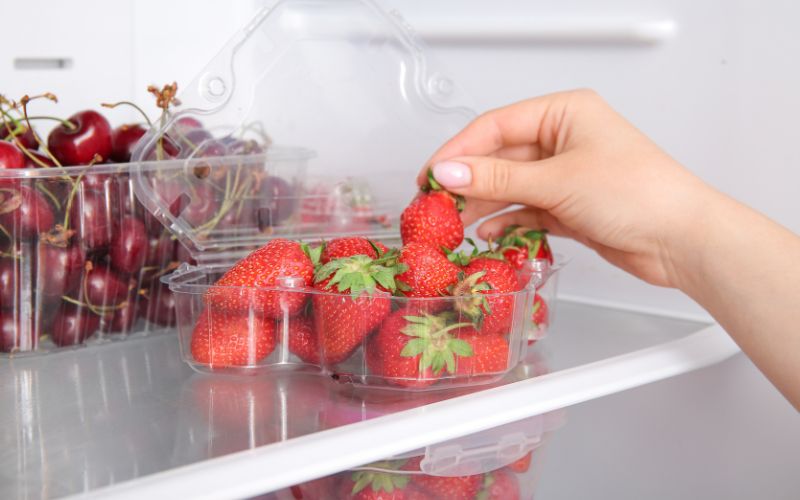Whether you’ve recently purchased a carton of plump and juicy strawberries from your local grocery store, picked them up at your favorite farmers’ market, or even harvested them yourself from your very own garden, one thing remains certain – you want to ensure that these vibrant gems are thoroughly cleaned before you indulge in their sweet and tangy goodness.
Nothing is more disheartening than reaching into your fridge, eagerly anticipating the burst of flavor from a perfectly ripe berry, only to discover that they have unexpectedly turned soft and fuzzy. We’ve all experienced that disappointment. Fresh produce, especially delicate berries like strawberries, require extra attention and care to maintain their peak freshness. However, with some additional love and the correct cleansing methods, you can savor the taste of your strawberries without any worries.
So, how should you clean your strawberries to extend their shelf life and preserve their delicious flavor? Fear not, for we have gathered a few valuable tips to help you keep your berries fresh and enjoyable for up to two weeks.
Wait — Then Wash Strawberries in Water
One classic method of keeping strawberries fresh for longer is to store them dry in the refrigerator. It is essential to wash the strawberries in water just before using them to ensure any bacteria and mold spores are removed.
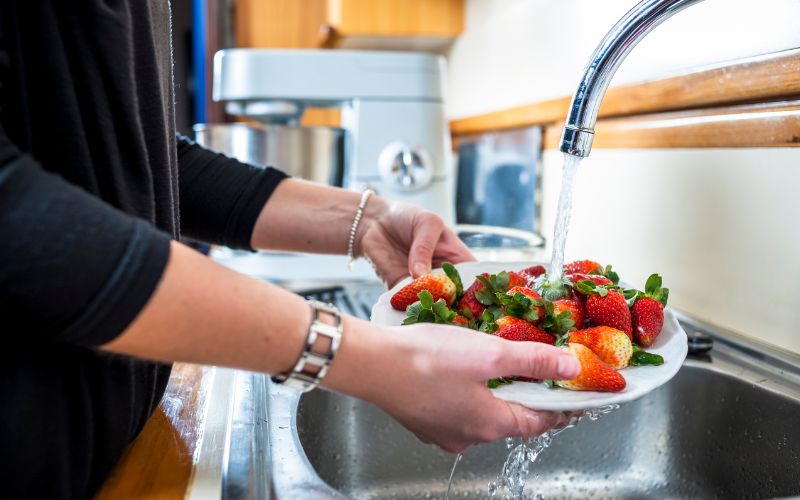
Excess moisture can lead to bacteria or mold growth, causing the berries to spoil more quickly. To prevent this, storing the strawberries in a perforated container that allows air to circulate or using a paper towel to absorb any extra moisture is recommended.
When ready to enjoy your strawberries, a simple rinse under cold tap water will suffice. This will effectively remove any minor bits of dirt or grit that may be present on the berries. After washing, you can pat the strawberries dry or allow them to thoroughly air dry before consuming or cooking them according to your preferences. These steps will help ensure your strawberries remain fresh and delicious for as long as possible.
Clean Strawberries with a Vinegar Soak
If you are concerned about bacteria and mold on your beloved berries or wish to extend their lifespan, fear not! There is a simple solution: soaking them in a gentle white vinegar mixture. As reported by the esteemed Detroit Free Press, the acidic nature of vinegar can effectively eliminate any lurking bacteria and mold spores that might be compromising the freshness of your berries. However, it’s important to note that after this soak, it is advisable to thoroughly rinse your fruit in water to minimize the possibility of an overpowering vinegary taste.
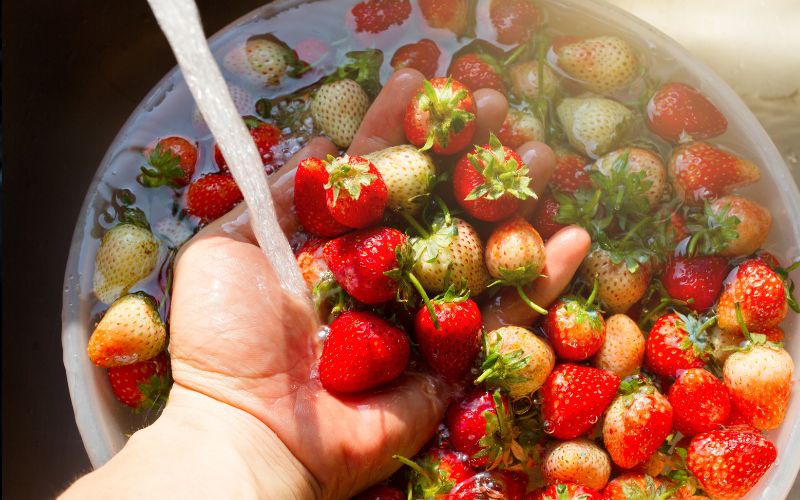
To create this magical vinegar solution, you only need to combine one part vinegar with three parts water in a generously sized container or bowl. Then, carefully place your precious strawberries into this vinegar-water concoction and allow them to luxuriate for approximately five minutes.
Once this short but transformative soak is complete, take the strawberries out and give them a good rinse using a colander. For the final touch, gently place your now refreshed and revitalized berries on a towel, allowing them to air dry completely. Once the berries have attained a state of perfect dryness, you may confidently store them in the refrigerator. Just use a container that permits proper air circulation, and voila! Your berries will remain in prime condition for a remarkable two weeks.
Wash Strawberries in Hot Water
Similar to the vinegar method mentioned earlier, this technique aims to eliminate any harmful bacteria or mold present on the surface of strawberries while preserving the integrity of the berries themselves. The concept was introduced by renowned food scientist Harold McGee, who highlights that strawberries naturally endure high temperatures during their growth process in the field.
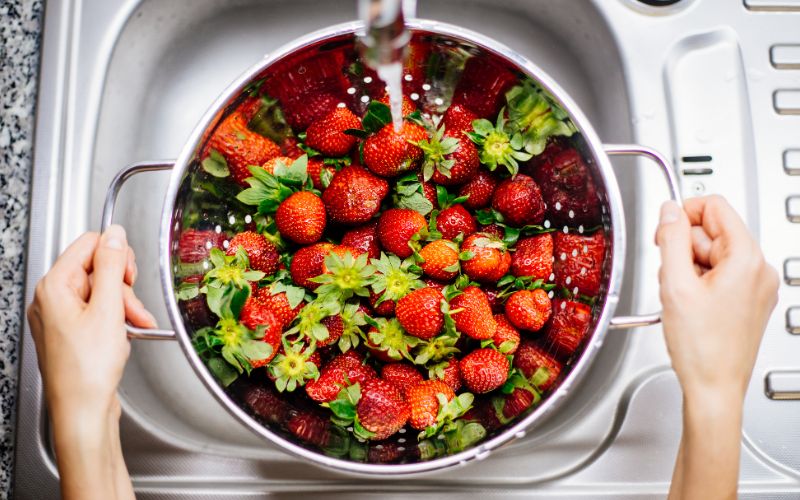
To employ this method, it is essential to have a reliable thermometer at hand. Begin by heating water to approximately 125°F, ensuring the temperature is accurate. Submerge the strawberries in the warm water for a brief period of around 30 seconds.
This gentle heat treatment effectively eradicates any bacteria without causing damage or overcooking the berries. Afterward, carefully place the strawberries on a towel to allow them to thoroughly dry. Finally, follow the storage instructions provided earlier to maintain their freshness. Following these steps, you can enjoy your strawberries for up to two weeks, knowing they have been appropriately treated for optimal safety.
Wash Strawberries with Baking Soda
If you happen to have a batch of delectable and fresh strawberries at your disposal but find yourself needing vinegar or an accurate thermometer within the confines of your household, fear not! There exists one final technique that can come to your aid.
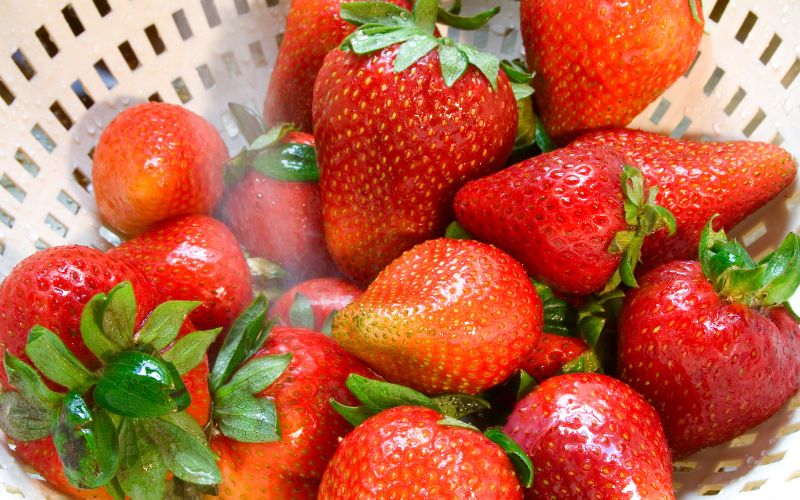
Rather than soaking the berries in an acidic substance, you can employ baking soda and soak them in a basic solution. This ingenious method sufficiently alters the pH balance to eliminate lurking bacteria or mold.
This particular approach, thoughtfully shared by Arm & Hammer, the renowned manufacturer of baking soda, operates as follows: introduce 1 teaspoon of baking soda into every 2 cups of cold water, ensuring a thorough blend.
Immerse the strawberries in this solution for up to 15 minutes. Once this time has elapsed, carefully remove the berries and allow them to dry completely. With this method, you are recommended to indulge in these freshly washed strawberries without delay, savoring their delightful flavors immediately.
How do you refrigerate washed strawberries?
Food52, a popular food website, provided a helpful tip to ensure the strawberries were thoroughly dried using a salad spinner lined with absorbent paper towels. This extra step guaranteed that the strawberries would be dehydrated before moving on to the next stage.

Following their guidance, I carefully transferred the dried strawberries into a container, lining it with more paper towels. It is important to note that the lid should be placed loosely on top of the container, avoiding any seal or tight closure. Once prepared, the strawberries container was placed inside the refrigerator to keep them fresh and ready to be enjoyed later.
Can you put washed strawberries in the fridge?
Yes, you can definitely put washed strawberries in the fridge. However, it’s important to note that it’s best to keep them refrigerated until just before serving. This helps to maintain their freshness and quality.
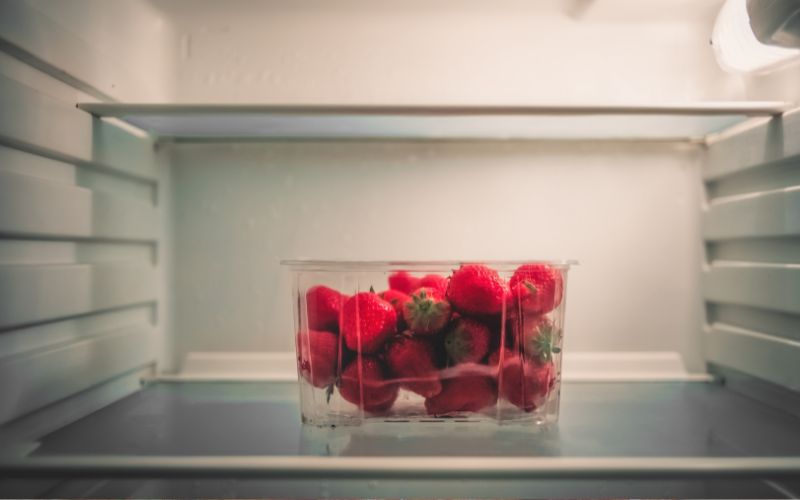
Before washing and consuming the strawberries, allowing them to sit at room temperature for approximately 15 minutes is recommended. This brief period at room temperature helps to enhance their flavor and texture. It’s also important to mention that you should never wash strawberries before refrigerating them, as this can expedite spoiling.
Can you wash strawberries before storing them?
Yes, it is not recommended to wash strawberries before storing them. Strawberries are best kept dry and cold to maintain their freshness. Washing them before storing can introduce excess moisture, which can cause the strawberries to become soft and promote mold growth. To keep your strawberries fresh, it is advised to wash them only when you are ready to eat or prepare them.
How do you keep strawberries fresh longer and washed?
You can follow these simple steps to keep strawberries fresh for an extended period and ensure they are thoroughly cleaned. Begin by creating a vinegar solution consisting of one white vinegar and three water parts.
Submerge the strawberries in this solution and let them soak for a few minutes. Once the soaking time is complete, carefully drain the strawberries and gently pat them dry using a clean paper towel. Transfer the strawberries to a glass container to maintain their freshness, ensuring they are arranged in a single layer.
Place a loosely fitting lid on the container and store it in the refrigerator for optimal storage. By following these instructions, you can prolong your strawberries’ shelf life while ensuring that they are properly washed and ready to enjoy.
How do you store strawberries after cutting and washing?
When storing strawberries after they have been cut and washed, it is essential to take the necessary precautions to maintain their freshness and prevent any potential bacterial growth. The best practice is to transfer the sliced strawberries into an airtight container, ensuring that the container is tightly sealed to create a protective barrier against air and moisture.
By doing so, you can effectively prevent the tender flesh of the strawberries from drying out and minimize the risk of harmful bacteria thriving on the surface. This simple step will help prolong the shelf life of your cut strawberries and ensure they remain juicy, vibrant, and safe for consumption.
Should washed strawberries be stored in an airtight container?
Yes, it is recommended to store washed strawberries in an airtight container. This is especially important when the strawberries have been cut or hulled, as the exposed flesh is more susceptible to mold and bacterial growth. By storing them in an airtight container, you can effectively protect the strawberries and extend their shelf life.
Do I wash strawberries before storing them in the glass jar?
According to Lynn Blanchard, the director of Better Homes & Gardens Test Kitchen, storing strawberries without washing them until you’re ready to use them is recommended. This is because when strawberries are washed before storage, they tend to absorb water, which can reduce their shelf life. So, the best practice is to leave them unwashed and whole until you’re ready to enjoy them.
Can you store strawberries in a Ziploc bag?
Yes, you can definitely store strawberries in a Ziploc bag. To ensure maximum freshness and longevity, place the strawberries in a Ziploc bag that comfortably accommodates them, ensuring they are not overcrowded.
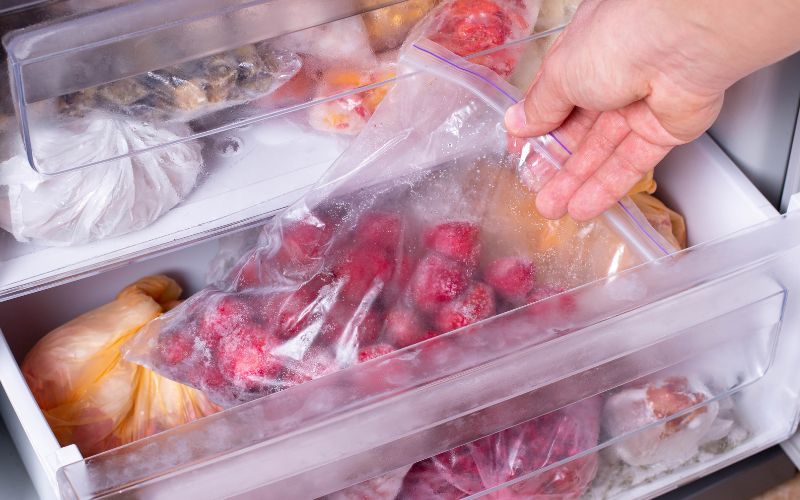
Once safely inside the bag, seal it tightly to create an airtight environment. Afterward, it is advisable to refrigerate the bag to maintain the strawberries’ cool temperature. By storing them in this manner, you can expect your strawberries to remain in good condition for approximately five to seven days.
It is important to note that the strawberries should stay dry and cold throughout their time in the bag, as this will help preserve their quality.
Can you store strawberries in a jar with water?
Yes, it is possible to store strawberries in a jar with water. By sealing the mason jar, you create an environment where no air can enter. Interestingly, this technique has been found to effectively delay the decay of the strawberries. The fruit retains its firmness, and the leaves maintain their vibrant color due to the natural moisture present in the berries.
Final Tips
As previously mentioned, moisture is the number one enemy of strawberries. Therefore, it is crucial to ensure they are dehydrated before storing them. To achieve this, gently pat them dry with paper towels, absorbing as much water as possible. Afterward, it is best to let them air dry on fresh paper towels until they are entirely moisture-free.
Once the strawberries have been cleaned and dried, storing them in an airtight container is essential. To further prevent any moisture buildup, it is recommended to line the container with additional paper towels. These towels will act as a barrier and absorb any excess moisture, thus prolonging the shelf life of the strawberries. Strawberries can last approximately two weeks in the refrigerator when stored properly.
It is essential to watch for any signs of mold on the strawberries. If you notice any moldy berries, it is crucial to remove them immediately to prevent the decay from spreading to the rest of the batch.
If you still need to take advantage of the bountiful strawberry season, now is perfect! Don’t let anything hold you back. Farm to Palms have a few delicious suggestions if you’re seeking inspiration for what to make with your fresh strawberries. One option is incorporating them into a refreshing Watercress and Strawberry Salad, where their natural sweetness pairs beautifully with the peppery watercress.
Another delectable idea is to cook ripe strawberries into a luscious Brandied Strawberry Shortcake topped with a dollop of Malted Whipped Cream. And if you find an abundance of strawberries that need to be used up, why not mix them into an irresistible Strawberry-Cabernet Barbecue Sauce and serve it over grilled chicken? The possibilities are endless for enjoying these vibrant and flavorful berries. So indulge in the sweetness of strawberry season while it lasts!

